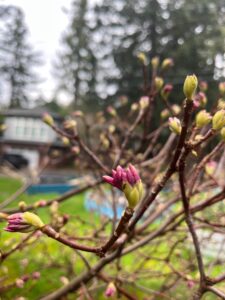It was neither ice nor heat. That is, not one single ice storm and not one single heat wave. The relentless strangeness of weather left the Daphne this way, budded around the edge but dead in the center. She will probably not last another hot summer.
Daphne is a Daphne odora “Marginata.” The cultivar “Marginata” indicates glossy leaves that sport a pale, bright edge. It was the odora though—the sweet, pink mid-winter scent reminiscent of Fruit Loops—that made us want her in the first place, and tend to her, and carry her with us from one house to another, that made us prop her up when she grew heavy and underplant her with special varieties of bleeding heart and black mondo grass that would best show her off, that made us love and root for her, over and over.

Her tag said—still says, because, to be clear, she’s still out there hanging on—Daphne o. “Marginata.” I used to repeat the length of that o when I was kneeling in the garden, the musicality of the phrase, the glory and the longing. Daphne o.
*
In the narrow Idaho valleys of my childhood, winter lasted late, and it was too cold for Daphne o. or anything else so fragrant. The dead of winter smelled only like exhaust, a scrim of black on refrozen ice, deadly sweet antifreeze, the grease of fried food cooling in cold air, drizzling rain. Wearing on, winter felt like the dirty, tightening coat I couldn’t bear to put on one more time.
And then some years there would be a reason to go to town in March or April and rediscover that over the mountains, just an hour away, there was a place that could sprout daffodils, its pavement bare and dry.
Later, at the University of Washington in Seattle, I experienced the Land Grant landscaping as lush and rich, a sign of having-made-it-out, though my presence at another state’s flagship was purchased at a high cost. The beauty was temporary, the belonging highly conditional. I’d walk out of class into the perfumed air of a mature, chest-high bank of Daphne o. knowing I lacked the means to stay in such places and uncertain that I would join the ranks of those productive enough to accrue wealth.
Shortly after, a common type of bright pink Camellia would bloom and fall, and its petals would cover the street, the raindrops bruising them with painterly, abstract patterns. The ambient urban arrangements of these common Camellias and slow Daphnes, the way they’d surprise me on a walk flowing over a fence line—the way I couldn’t purchase them as cut flowers—made me first long for property.
Property: the idea of having space to plant, the possibility of a garden, a place to make beautiful and the rent not rising. It was a dream that squeezed out other, probably more worthwhile ambitions. It was almost unthinkable, but in the nineties, not quite. I didn’t question the way beauty, creative control, and property linked up in my mind. I didn’t fully buy the idea of meritocracy, nor did I feel entitled to ascend very far. But I did think I could leverage my little merit, officially confirmed by test scores and degrees, and ride it just far enough to be able to plant a garden full of extravagant flowers.
*
Years later, partnered, in a small house with a very small yard in which previous inhabitants had sometimes buried garbage when they couldn’t afford garbage collection, I planted my own Daphne o. “Marginata.” They were the first plants I wanted to put in the ground. I bought two small shrubs, to be safe, in case one failed.
House secured, we found an ad for a puppy of mixed hunting breeds who cost a hundred dollars. One of her first actions was tugging a Daphne o. “Marginata” from the ground and shaking, shaking, shaking it dead.
The remaining plant grew too slowly to really cloud the air. Too much shade, we thought, probably incorrectly. I watched her nervously and tiptoed across cold stones in my robe to smell her sparse blossoms.
And then some years later, moving across town to clay soil and a large, tricky lot, we gave her what we thought was the best possible shot, a spot right by the front door with partial sun much of the year, plentiful mulch. We planted around her for maximum contrast and beauty. With time, she branched and grew into one of the properly middle-aged specimens I used to see sometimes in the old neighborhood. I exhorted the kids to bend down on the way to the pre-pandemic school bus in the middle of February, attend to the miraculous clusters with their unlikely scent, but they shrugged and went on their way, having no idea then, when the bus still came, of harder winters.
*
Climate change works its chaos differently in different places. In Portland, it seems like we have lost temperance. The summers are hotter, the droughts long and absolute, turning what used to be a season for swimming into one where ponds and creeks fill with a slime that sickens dogs. And the winter brings its own wet weirdness. Snow and ice storms arrive more often and last longer. We have become used to the so-called hundred-year weather event arriving every two or three years. Trees fall, branches break, pipes burst, schools close sometimes weeks or longer, power fails, people die, and we simply wait for the next emergency, no better prepared than we were, individually or collectively, for the last one.
Over the years, the Daphne lost leaves here and there, but she was sturdy and came back. And then in 2023, at the end of February when Daphne o. was blooming, an ice storm arrived. Snow hung in the crooks of her branches, ice glazed her blossoms, crystalling each tired leaf. The earlier winter had been strangely warm and so this storm had unexpected effects: huge branches fell from magnolias and cedars alike, as if the trees had readied themselves for something different, as if they were heavy with a coming spring that was not to be. You could hear the neighborhood cracking as limbs fell.
It’s true that the Daphne I love originates in Asia, like many shade loving plants that used to be heavily featured in Pacific Northwest high-status gardens. Genetically, she is not so long adapted to this place. The abundant sword ferns and mahonia and woodland violets that carpet much of the lot we live on are indigenous to this area; so far, they seem hardened even to this whiplash weather. And it’s true that my book knowledge of Daphne o. “Marginata” is from the gardening internet, a thin set of semi-facts, only vaguely rooted in place.
After the ice melted, her leaves were limp and dead.
“That might be the end,” my mom said. She had her own storm-burned Daphne.
But by spring I could see new leaves coming, small and abundant. I loved to see her fighting back, returning to us. She greened up beautifully in summer, just in time for two warm weeks—not record-breaking, just sunny and hot—that I had no idea would burn all those new leaves right up without any of the old ones there to shade them. She who had survived a heat dome—120 degree temperatures in the Pacific Northwest—without accommodation, did not survive a couple of 90-degree weeks.
She opened her leaves in warm air. It was risky and I didn’t know it.
*
Last week, I went back to the University campus where I first encountered the pink-frosted clouds of Daphne o. “Marginata.” I saw none. I saw fewer hedges, more tangles and thickets, more native plants. I also passed a well-supported, thriving clematis vine that made me start mentally planning when and where and how I would grow it.
*
On a Zoom call, I am speaking with women my age—writers, moms. We’re calling to share work. We’re calling to check in on each other. We have been reading each other for twenty years. To age with friends is an incredible good fortune, a gift of the universe. In their faces I can see the girls they were and the women they are, silliness giving way to sorrow and wisdom and a deeper kind of silliness.
We’re talking about strangeness, the speculative, possible futures.
“I don’t know,” my friend Sara says. “Did you imagine the world would turn out this way?” Her words break the spell of everyday life, the routines we maintain as an act of resilience, despite the underlying sense that every piece of infrastructure on which we depend, whether we want to or not—schools, the industries that employ us, the healthcare system, the baseline democratic functioning of government, the fundamental predictability of weather—is falling apart.
As we’re having this conversation, Daphne o. is out there, waiting to open a few sparse buds. It’s still too cold on our hillside. Or maybe she’s too damaged. She was born into one time and lived into another, and the acceleration from predictability to a now we can’t quite recognize happened faster than it might have.
All that she’s survived has formed her into the shape of a crown. The sight of her tears at me. I can’t imagine pulling her up. I can’t imagine neglecting her on purpose. I don’t know if she can still be beautiful.
Jessica E. Johnson writes poetry, nonfiction, and between genres. She’s the author of forthcoming memoir Mettlework: A Mining Daughter on Making Home, the book-length poem Metabolics, and the chapbook In Absolutes We Seek Each Other.
Photo courtesy of the author.



